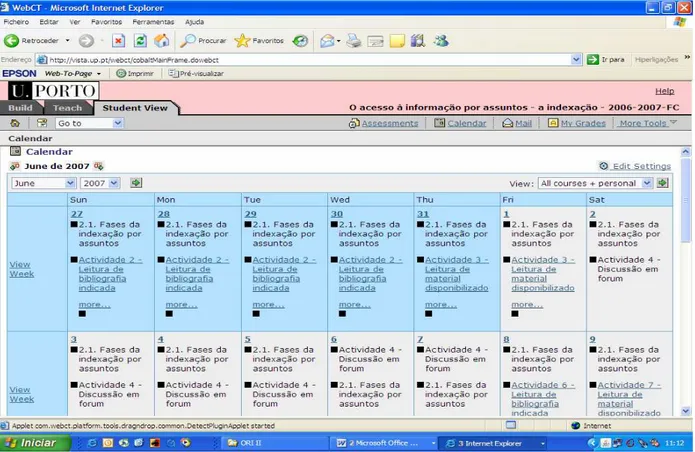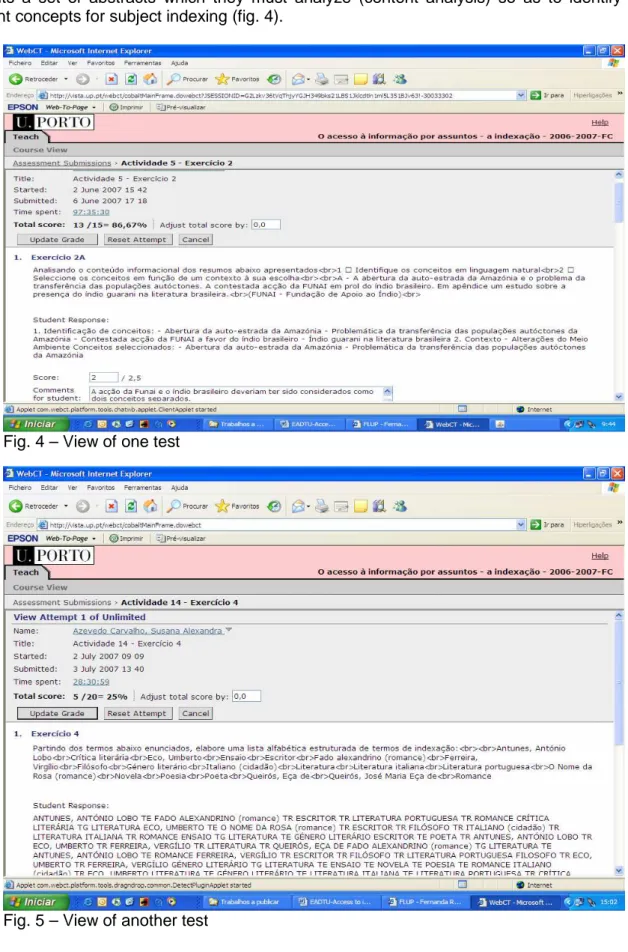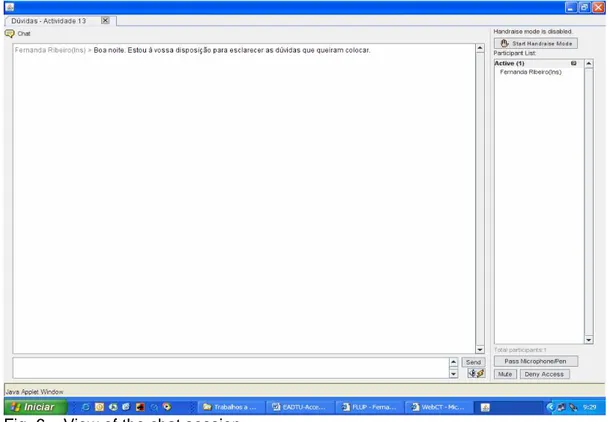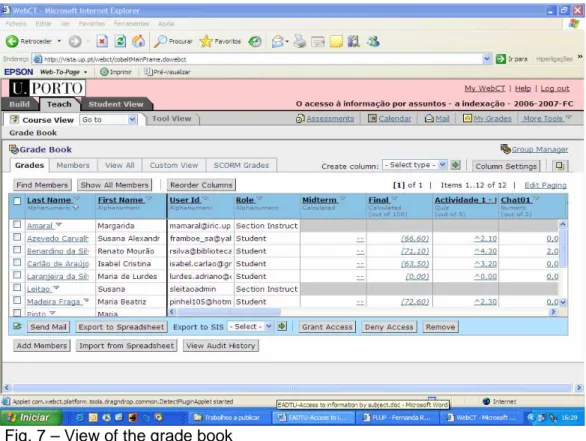Title of paper:
“Access to information by subject”: a course aimed at
improving knowledge in the field of subject indexing
Author: Fernanda Ribeiro
Affiliation: Faculdade de Letras da Universidade do Porto E-mail: fribeiro@letras.up.pt
Abstract
The aim of this paper is to describe the main goals and structure of an e-learning course aimed at improving knowledge in the field of subject indexing, within the scope, obviously, of Information Science. The course does not foresee any face-to-face teaching and is designed such that students follow a programme with an increasing degree of difficulty, in order to be able to produce subject access points to information and to build a structured list of indexing terms (thesaurus).
The content analysis is thoroughly discussed and put into practice through several assessment modes and the representation of concepts is also extensively discussed by the students in a forum and chat sessions with the instructor.
The course presents a detailed programme, following a carefully structured calendar, and envisages a model of teaching and learning based on the progressive acquisition of concepts and knowledge. It requires solid organization and well-defined rules that have acted, until now, as factors that have sustained the students’ interest and dedication over the six weeks of the course.
This type of course fills a recognized gap in most of the regular courses offered by the universities in Portugal, and has thus attracted the attention mainly of information professionals who work in libraries, archives and other information services.
Keywords: subject indexing, progressive learning, information training
1. Introduction
The course in “access to information by subject” was developed in 2005 and ran for the first time that year as a pilot experience. Two more editions have been offered since (2006 and 2007), which have attracted students from all over the country. The course does not involve any classroom training, that is, the students do not generally know each other or the instructor personally.
The course started based on the WEBCT Campus Edition e-learning platform and evolved to WEBCT VISTA, which enabled the use of new functionalities and an improved course design, as well as easier communication with the students. Even though the platform’s functionalities are not used to full potential, those that are activated fulfil the objectives established for the course. In the future, other possibilities may be explored in order to develop more dynamic activities, namely assessment and assignments, which can improve and broaden the possibilities of practical training in subject indexing throughout the course.
The technological support to this course is provided by an office dedicated to the use of new technologies in education (GATIUP) that is part of the University of Porto. The students and the instructor benefit from its support whenever technological problems occur with the use of the e-learning platform.
The primary aim of this paper is to describe the course and provide some reflection on the matter. But it may also prove useful in evaluating its strengths and weaknesses, thus exploring improvements that can be considered in future editions.
2. Objectives and scope of the course
The idea of creating an e-learning course in subject indexing resulted from the fact there is a clear lack of continuous education in this area countered by a pressing demand for this type of training from information professionals (librarians, archivists and documentalists).
The main objective was, in fact, to provide an opportunity for continuous education to working professionals, giving them the possibility to update their knowledge and practical training in the field of subject indexing.
Subject indexing is an important technical operation in the area of Information Science. Its main purpose is to represent the contents of a document through a controlled language that establishes access points to the retrieval of information in any type of information system. In a first stage, the process of subject indexing demands procedures of content analysis in order to identify the main subject and the concepts that represent the content of a document and, in a second stage, the representation of those concepts through an indexing language, that is, a controlled vocabulary that compiles the terms or codes used as access points in the process of information retrieval. The establishment of the most correct indexing terms to be used in the users’ information searches requires a theoretical grounding, a methodological basis and the command of technical procedures. All these components make the process of subject indexing complex and slow, and imply the need for continuous training so as to develop a consistent and efficient indexing policy.
The course deals about the subject indexing process as a whole, focusing on content analysis, concepts representation and construction of a controlled vocabulary, applying in all these stages the international (and national) standards dedicated to the matter (ISO 5963 = NP 3175 and ISO 2788 = NP 4036) (Portugal, 1989 and 1993).
3. Structure of the course
This course has the duration of six weeks and presumes the development of several activities over that time. These activities follow the programme established for the course, which is available from the main menu (fig. 1) under “Documentos de apoio”. In this topic the students not only find the programme, but also supporting documentation (texts organized by the instructor, standards used in the process of subject indexing and other bibliographic materials), as well as the evaluation criteria defined for the course (fig. 2).
The organization of the course is based on a clear, detailed statement of the activities proposed for each day in the calendar. The students have to consult the calendar everyday, where the activities they must accomplish are clearly listed and the estimated time required for each task is indicated. Links are also provided to supporting documentation, to the discussions in which they should participate or to the assessment tasks they must carry out. Thus, throughout the course, the students follow the calendar, clearly understanding each stage in the programme and its corresponding activities (fig. 3).
Fig. 1 – Main menu – student’s view
Fig. 3 – View of the calendar with the planning of activities
Usually the activities proposed remain active for a few days, since they imply the prior reading of supporting documentation or discussion on the readings accomplished and written assignments.
The instructor’s main concern is to organize the calendar as efficiently and clearly as possible, so to avoid doubts from students about what is expected from them. The calendar is the course’s backbone and represents the framework in which the students have to work.
4. The learning activities
The course comprises different types of activities, to be accomplished individually or in groups, a number of which are obligatory to successfully pass the course. The activities are defined in accordance with the course’s programme and have to be accomplished step by step. In effect, this course is geared at the progressive acquisition of knowledge and broadening the students’ understanding of the subject indexing process in its different phases, which means that it is important to perform a sequence of procedures methodologically.
The activities are programmed daily and may be accomplished in one day or in several days. A recurrent task throughout the course involves the reading of bibliographic material and other supporting documentation. At times, students have three or four days to read the texts proposed, and then write a summary report or discuss their findings with their colleagues in the forum.
The forum discussions take place throughout the course, usually complementing the readings proposed, and they are active for a few days. This type of group activity is highly appreciated on the part of the students, as it provides an opportunity to exchange opinions and does, to some extent, allow them to get to know each other. The groups are established by the instructor
(usually three students per group) and each group has a specific forum to discuss its assigned topic and respective readings.
In order to successfully conclude the course, it is compulsory to comply with the assessment tasks. There are four individual assessment assignments students must accomplish, comprising open questions to which student reply in essay form. One of the tests, for example, gives the students a set of abstracts which they must analyze (content analysis) so as to identify the relevant concepts for subject indexing (fig. 4).
Fig. 4 – View of one test
Another test supplies an alphabetical list of indexing terms and the students are asked to organize a structured list with semantic relationships between the indexing terms, that is, a list resembling entries in a thesaurus (fig. 5).
A chat session is held with the students once a week, essentially aimed at clarifying students’ doubts. The instructor stays online one and a half hours each week and organizes the debate through the platform, which allows for a very interesting and systematic approach in what concerns the management of the interventions. The students use a functionality where they can ‘raise a hand’ to ask permission to take part in the discussion and the instructor manages the requests giving the microphone to the students in the order in which the requests were made (fig. 6).
Fig. 6 – View of the chat session
As a complementary component to the activities described there is a permanently active general forum, dedicated to exchanging comments or doubts among the students and/or the instructor and there is also the e-mail functionality used as a means to communicate with the instructor or to exchange messages among the students.
5. The role of the instructor
As in the majority of e-learning courses, the instructor’s function is mainly to supervise. Although playing a fundamental role when it comes to the planning of activities and course organization, once the course begins, the instructor essentially supervises the students’ performance. He/she has to be particularly attentive to the students’ doubts sent by e-mail or posted on the general forum. It is essential that the instructor reply as quickly as possible (on the same day) to the questions and provide feedback since, in many cases, the development of a task may depend on the clarification of a certain doubt.
Moreover, the instructor has to be efficient when it comes to the evaluation of the activities. The students become increasingly more motivated if they receive feedback from the instructor
rapidly and they often complain if there is some delay in making grades available or in answering e-mails.
It should be noted, though, that the instructor’s contribution which students usually most highly appreciate is the interaction that develops in chat sessions. They have the possibility to clarify their doubts in real time and express their opinions about the course, the progress they have made, and the difficulties they experience. They also benefit when clarifying scientific questions such as understanding concepts and terminology, technical procedures, etc.
6. Student Evaluation: grades and the grade book
At the beginning of the course, students are informed of the evaluation criteria. The activities are graded on a scale that goes from 0 to 100 points and the students need to accumulate at least 50 points to pass the course. There are fourteen activities but only four (individual) assessment tasks are compulsory, which means that if students do not accomplish one of these, they will not be awarded the final certificate, even if they obtain more than 50 points. The other activities are optional, but the students must carry out a certain number of them, otherwise they will not collect enough points to pass the course.
The instructor evaluates each activity once it is concluded and posts the correspondent marks in the grade book, which the students can consult by clicking on the button “my grades” in the main menu (fig. 7). Thus, the grade book shows the points given to each activity and the total number of points collected by each student. Thus, students can easily keep track of their performance and the instructor’s evaluation.
Fig. 7 – View of the grade book
7. Evaluation of the course: the students’ opinion
One of the best ways to improve a course is to ascertain its weaknesses and limitations. And determining its less attractive aspects can be partially accomplished by finding out the students’
opinions. At the end of each edition of the course an anonymous questionnaire is made available to be answered by the students.
The questionnaire starts with a set of questions aimed at characterizing the respondents (age, education, sex, frequency of Internet use, familiarity with computers, etc.) and another set of questions through which students can express their opinion about the course, the technological platform and the instructor’s performance. They also give their opinion about what they consider can be improved in the course (fig. 8).
Fig. 8 – View of the questionnaire
In the course’s three editions, the number of students who accomplished the entire programme has been quite low, that is, less than ten students in each edition: in the first course only nine students completed all the activities, in the second, eight students, and in the third, only seven. There were more applications but some students withdrew at the end of the first week, explaining that they did not have the time to follow such an intensive programme since they did not have internet connections outside their place of work.
In all the editions, on average, the answers to the questionnaire were located between “good” and “very good”; in fact, none of the items in the questionnaire were classified below “good”. Some students suggested the creation of a permanent forum of discussion using the WEBCT VISTA platform to keep the debate alive on the topic of “subject indexing”.
8. Final remarks
Even though the number of students enrolled in each edition has been quite low, we can conclude, on the basis of those who participated and successfully completed the course, that
there is potential and a “market” for this type of training. The students are generally very interested, accomplishing the activities earnestly and encouraging the instructor with questions in order to learn more.
The chat sessions provide an opportunity for real-time communication, and students have revealed that the course has undoubtedly contributed greatly to improving their knowledge and understanding.
Another aspect that should be highlighted is the importance of assessment tasks as a way to test the students’ knowledge. One area that could be improved is the addition of more tests and assignments, particularly auto-tests. If these are made available with automatic corrections, the students can easily evaluate their progress.
Subject indexing is considered a complex technique by information professionals (librarians, archivists, information managers, etc.) and a task that requires a high level of training. Usually it is taught in regular / traditional undergraduate or postgraduate courses. Even though the course is mainly directed at people who have some prior knowledge of subject indexing, it has been proven that some students who did not have any previous training in this field can acquire a minimum level of knowledge and accomplish tasks in subject indexing. Thus, with a number of developments (more supporting documentation and more practical activities), it could possibly be adapted to train people without any previous training in the matter.
References:
Portugal. Instituto Português da Qualidade. Comissão Técnica 7 (1989). Norma portuguesa 3715 : documentação : método para a análise de documentos, determinação do seu conteúdo e selecção de termos de indexação, Lisboa, I. P. Q.
Portugal. Instituto Português da Qualidade. Comissão Técnica 7 (1993). Norma portuguesa 4036 : documentação : tesauros monolingues : directivas para a sua construção e desenvolvimento, Lisboa, I. P. Q.





